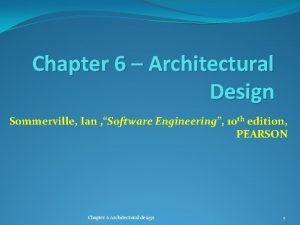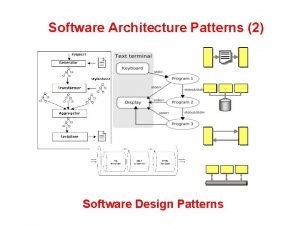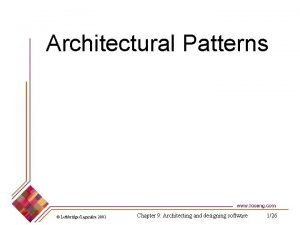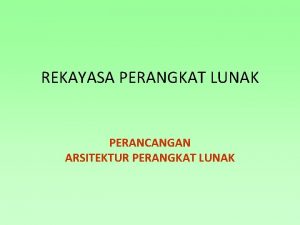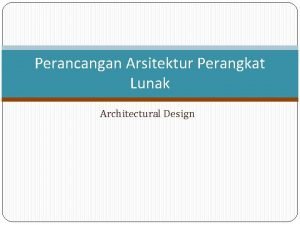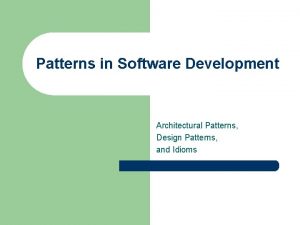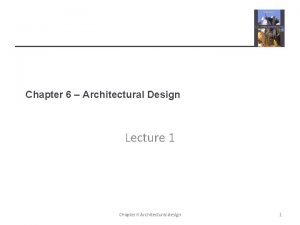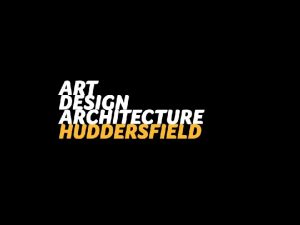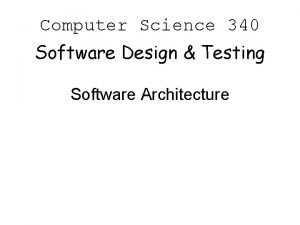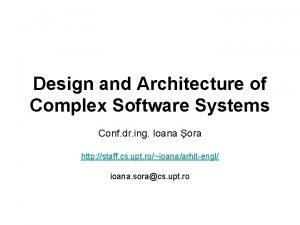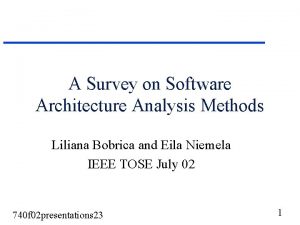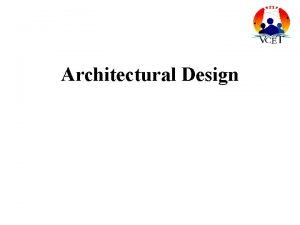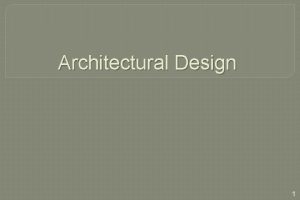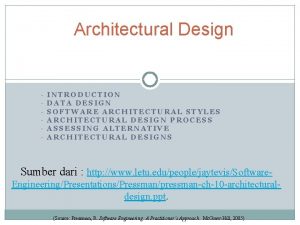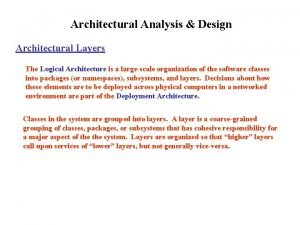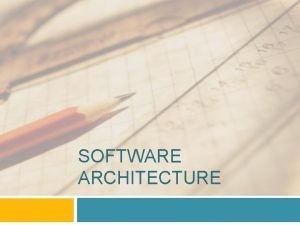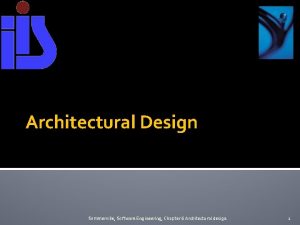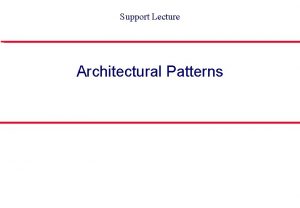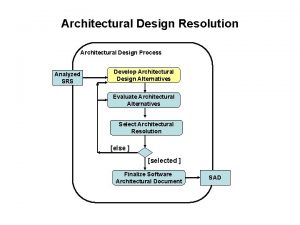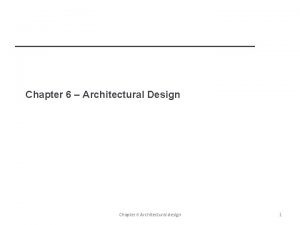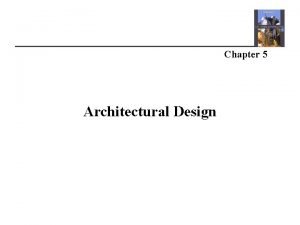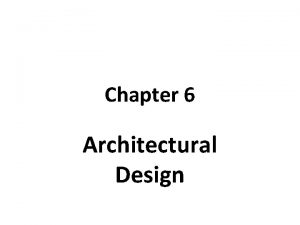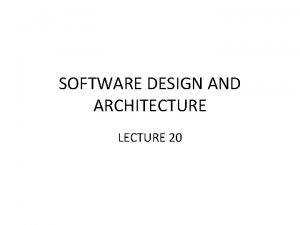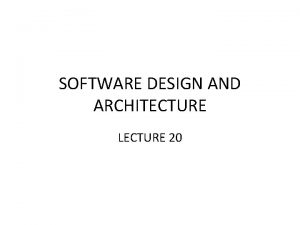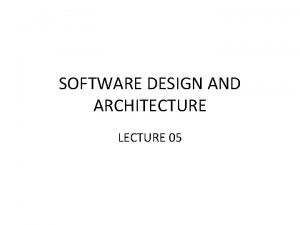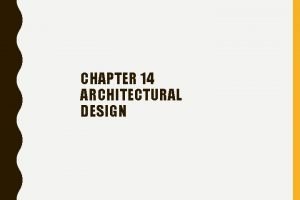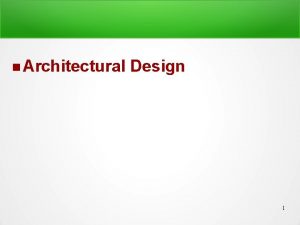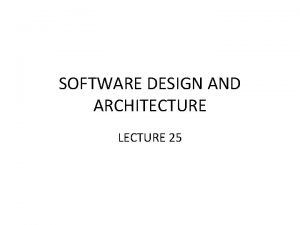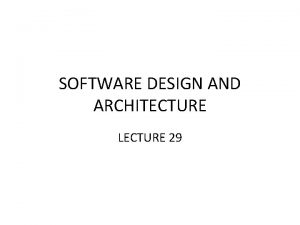SOFTWARE DESIGN AND ARCHITECTURE LECTURE 07 Review Architectural



























- Slides: 27

SOFTWARE DESIGN AND ARCHITECTURE LECTURE 07

Review • Architectural Representation – Using UML – Using ADL

Outline • Introduction to architectural styles • Categorizations of architectural styles • Hierarchical architectures – Layered Architecture

Architectural Styles • An architecture style (also known as an “architecture pattern”) abstracts the common properties of a family of similar designs. • Define a family of systems in terms of a pattern of its structural organization.

Components of a style The key components of an architecture style are: • Elements/components – that perform functions required by a system • connectors – that enable communication, coordination, and cooperation among elements • constraints – that define how elements can be integrated to form the system • attributes – that describe the advantages and disadvantages of the chosen structure

Categories of Architectural Styles • Hierarchal Software Architecture – Layered • Distributed Software Architecture – Client Server – SOA • Data Flow Software Architecture – Pipe n Filter – Batch Sequential • Event Based Software Architecture • Data Centered Software Architecture – Black board – Shared Repository • Interaction-Oriented Software Architectures – Model View Controller • Component-Based Software Architecture

HIERARCHAL SOFTWARE ARCHITECTURE

Hierarchal Style • The hierarchical software architecture is characterized by viewing the entire system as a hierarchy structure. • The software system is decomposed into logical modules (subsystems) at different levels in the hierarchy.

Hierarchal Style • Modules at different levels are connected by explicit or implicit method invocations. – a lower-level module provides services to its adjacent upper-level modules, which invokes the methods or procedures in the lower level.

Hierarchal Style • System software is typically designed using the hierarchical architecture style; – examples include Microsoft. NET, Unix operating system, TCP/IP, etc.

Hierarchal Style • Lower levels provide more specific functionality down to fundamental utility services – such as I/O services, transaction, scheduling, and security services, etc. • Middle layers, in an application setting, provide more domain- dependent functions – such as business logic or core processing services. • Upper layers provide more abstract functionality in the form of user interfaces – such as command line interpreters, GUIs, Shell programming facilities, etc.

LAYERED ARCHITECTURE

Layered Style • Organized hierarchically into layers. • Each layer provides service to the layer above it and serves as a client to the layer below. • The connectors are defined by the protocols that determine how the layers will interact.

A generic Layered Architecture

A partial layered architecture example

Specializations • Often exceptions are made to permit nonadjacent layers to communicate directly. – This is usually done for efficiency reasons.

Example: • Library system • Allows controlled electronic access to copyright material from a group of university libraries. • Bottom layer being the individual database in each library. • Components?

• Components: – UI – Authentication and forms – Search engine – Document retrieval – Rights manager – Accounts management – databases

Example: Library System • Ref: Software Engineering - Sommerville

Applicable domains of layered architecture: • Any system that can be divided between the application-specific portions and platformspecific portions which provide generic services to the application of the system.

Applicable domains of layered architecture: • Applications that have clean divisions between core services, critical services, user interface services, etc. • Applications that have a number of classes that are closely related to each other so that they can be grouped together into a package to provide the services to others.

Benefits: • Incremental software development based on increasing levels of abstraction. • Enhanced independence of upper layer to lower layer since there is no impact from the changes of lower layer services as long as their interfaces remain unchanged.

Benefits: • Enhanced flexibility: interchangeability and reusability are enhanced due to the separation of the standard interface and its implementation.

Benefits: • Component-based technology is a suitable technology to implement layered architecture; this makes it much easier for the system to allow for plug-and-play of new components. • Promotion of portability: each layer can be an abstract machine deployed independently.

Limitations: • Lower runtime performance since a client's request or a response to a client must go through potentially several layers. • There also performance concerns of overhead on the data processing and buffering by each layer.

• Many applications cannot fit this architecture design. • Breach of interlayer communication may cause deadlocks, and “bridging” may cause tight coupling. • Exceptions and error handling are issues in the layered architecture, since faults in one layer must propagate upward to all calling layers.

Summary • Introduction to architectural styles • Categorizations of architectural styles • Hierarchical architectures – Layered Architecture
 Architectural design in software engineering
Architectural design in software engineering Architectural scale review answer key
Architectural scale review answer key Data centered architecture
Data centered architecture 01:640:244 lecture notes - lecture 15: plat, idah, farad
01:640:244 lecture notes - lecture 15: plat, idah, farad Blackboard design pattern
Blackboard design pattern Architectural pattern in software engineering
Architectural pattern in software engineering Software architecture diagram
Software architecture diagram Desain arsitektur perangkat lunak
Desain arsitektur perangkat lunak Architectural patterns in software engineering
Architectural patterns in software engineering Architecture review board charter template
Architecture review board charter template Architectural design
Architectural design Architectural design in huddersfield
Architectural design in huddersfield Design objectives
Design objectives Flowchart for airline reservation system
Flowchart for airline reservation system Architectural design workflow
Architectural design workflow The architecture business cycle
The architecture business cycle Eic software software review
Eic software software review Design architecture software
Design architecture software Software architecture design
Software architecture design Software architecture design
Software architecture design Computer architecture notes
Computer architecture notes Microarchitecture vs isa
Microarchitecture vs isa Real time software design in software engineering
Real time software design in software engineering Design principles in software engineering
Design principles in software engineering Call and return architecture example
Call and return architecture example Iot conceptual view
Iot conceptual view Architectural styles and patterns
Architectural styles and patterns Internetworking concept and architectural model
Internetworking concept and architectural model
